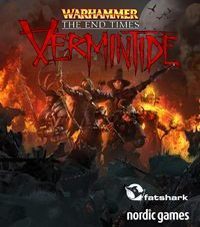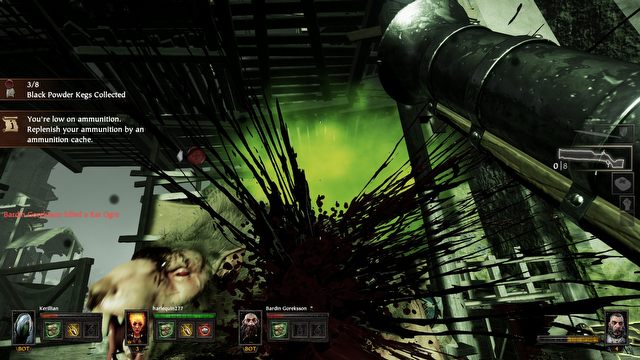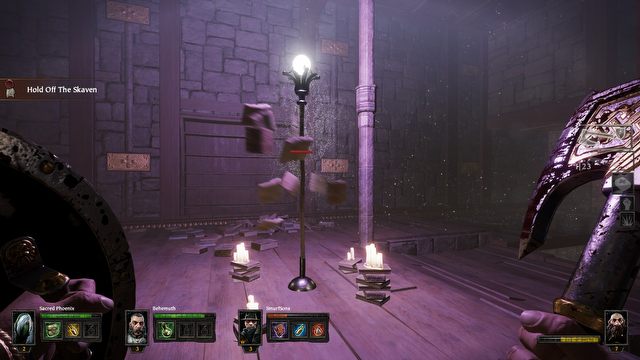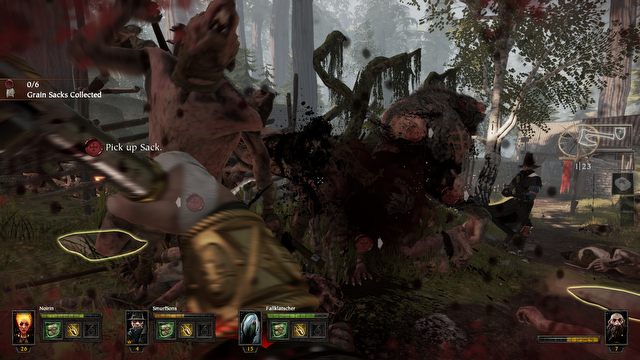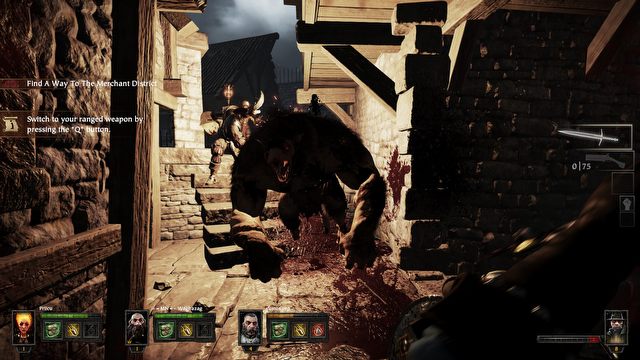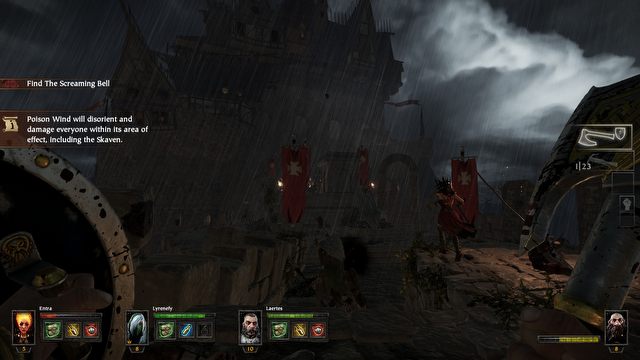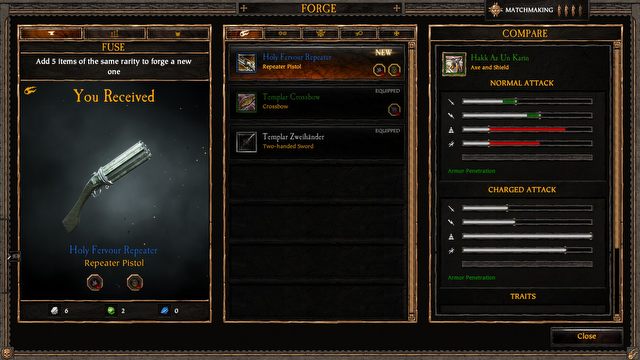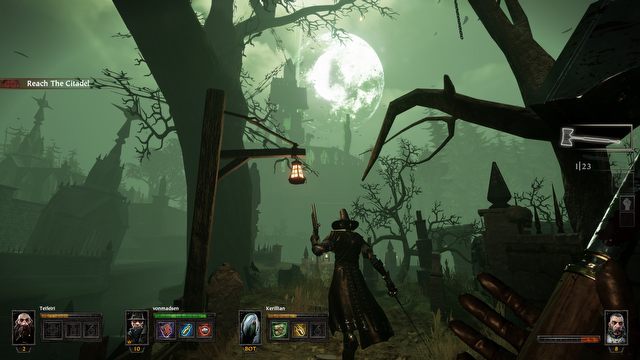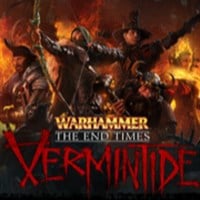Warhammer: The End Times – Vermintide Review – a.k.a. Left 4 Rats
On paper, the premise of combining Left 4 Dead and the Warhammer universe looks absolutely brilliant. Will the beloved co-op formula turn out to be a blockbuster when transplanted into a world full of Skavens?
The review is based on the PC version.
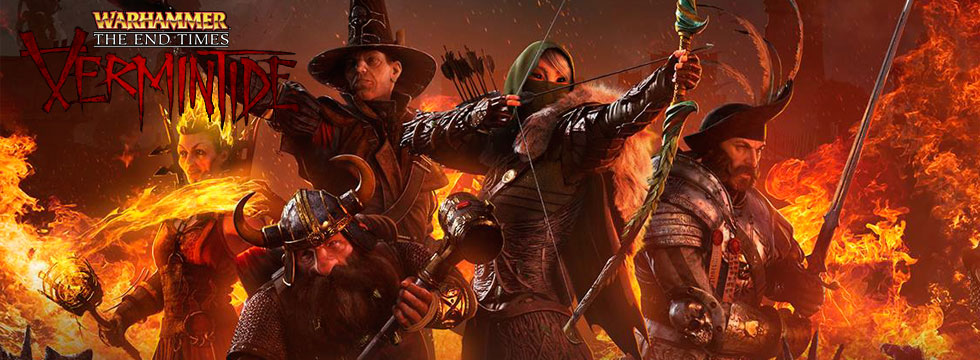
- very satisfying combat mechanics;
- that distinctive Warhammer feel;
- well-ballanced classes;
- the progression system makes you want to keep playing;
- location designs;
- great music and visuals.
- staggering number of bugs and various issues;
- most of the missions are not worth repeating;
- enemy AI is BAD;
- can get repetitive sometimes.
I wasn’t particularly happy a few years ago, when Games Workshop began tossing the Warhammer franchise licenses at companies here and there. To be honest, I’m not a big fan of the franchise itself and I had very few occasions to try out its physical iteration. Nevertheless, I believe the thing that constitutes the essence of such games loses much of its charm when digitalized. It’s true, Warhammer: Dawn of War and its sequels turned out wonderful and I had some prime time playing them, but the rest… Although to be fair, after spending some time with Mordheim: City of the Damned and Warhammer 40,000: Regicide, I have to admit that sometimes even a small and obscure developer studios can make pretty decent games. As soon as I’ve heard the announcement of the Left 4 Dead inspired Warhammer: The End Times – Vermintide, I hoped for a similar case. It is most likely that we’ll have to wait a long time before the third part of the revered zombie co-op shooter is released, and thus we should enjoy whatever Fatshark Studios has in store for us. Assuming it’s a thing which can be enjoyed…
A bit of chaos won’t hurt anyone
From the very beginning, Warhammer: The End Times – Vemintide leaves no place for speculations – it is an almost exclusively action-oriented game, and although the universe that serves as its setting could easily deliver some more intricate plot… it doesn’t. We find ourselves in the city of Ubersreik, which recently happened to be invaded by the Skaven. As you would expect, humanoid rats are not the most noble of creatures and our player-controlled heroes have been tasked with exterminating the vermin from this once-beautiful city. The group is coordinated by an inn-keeper, who doubles as a narrator. Although to be honest, he might as well be absent – his lines are limited to a single, sometimes composite sentence spoken before each mission, and provide next to nothing in terms of consistent narrative in between them. Might as well sum it all up as: “Just kill the Skavens!”. Now, I wasn’t expecting complex dialogues or multi-layered plot-twists in this kind of game, but it’s a shame we don’t get to immerse ourselves a bit deeper into this grim setting.
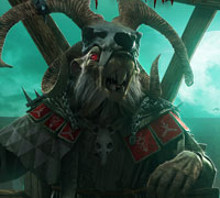
Although we meet several types of enemies in the game, virtually all of them can be traced back to their Left 4 Dead archetypes. Other than the typical Skaven, basically a zombie-ersatz, we will face: gigantic, mutated rats (Tanks), packmasters (Smokers), assassins (Hunters), poisonous grenade-throwers (Spitters), armed commanders patrolling the city (Witches) as well as rats armed with a high-powered something called the rattling gun (can be compared to Chargers)
The only thing visibly connected to the Warhammer universe are the character classes we have at our disposal. There are five of them in total, while our team can have four people at most. The classes are: Witch Hunter, Empire Soldier, Dwarf Ranger, Bright Wizard (a pyromancer), and Waywatcher (an elven huntress). Each class is represented by a unique character with a distinctive personality. After playing several missions, I’ve noticed that all of them are well-designed and fairly balanced. Each character possesses only two types of attack – melee and ranged – but there are several variants to choose from, and all of them are very useful. The Dwarf makes for a better melee fighter than the pyromancer, obviously, but this doesn’t equal to one of them being weaker than the other. Even if one engagement can make a character seem useless, in the next one the same character can save the day. The group members complement each other and – what is more important – each of them is equally fun to play. In games like this one, I usually tend to find my personal favorite very quickly and then make them my exclusive choice. This time, I had no problem with playing as different characters while having loads of fun every time.
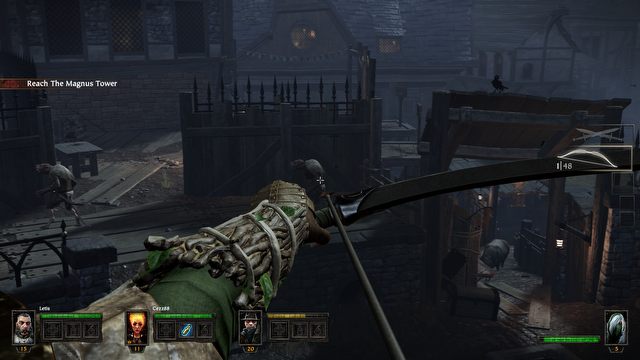
It's not nice to barge in without an invitation, but in the Old World there is no place for good manners.
Where would you rat-her be?
You will be seeing the expression “loads of fun” quite often in this review, I think. In no small thanks to the mission designs. There are thirteen missions in total, and although they are rather simplistic, and some motives you will be seeing more than once, I have to say that they are also surprisingly engaging. Typically, we begin at point A and make our way to point B, while completing additional tasks on the way (and leaving piles of dead Skaven in our wake). That’s hardly a refined procedure, I know, but the team at Fatshark made sure that the action is served accordingly, leaving no spare time for pointless running in circles looking for the right direction. Constant clicking may irritate some of you, but at least the missions themselves are truly unique, you have to applaud that. One time, we have to carry grain sacks, some other time we go in to blow up a Skaven hideout only to end up lost in a wizard’s tower and eventually face a leader of the local bandits. On a more general note, all of the missions can be said to be just more of the same, but the unusual locations we traverse do a pretty decent job hiding that fact.
In spite of a the relatively pleasant basic formula, the mission design has a certain, rather serious drawback, which comes into fray as soon as we complete the campaign and begin the unavoidable endgame grind sessions. I mentioned “loads of fun” earlier so what’s my problem, right? It’s something called “viability” – there are tasks that, with some practice, can be completed very quickly, while some others seem to drag on forever. Initially it takes from 20 to 30 minutes to complete any of them, but for some missions, and with a good crew, this time can be cut down by half… which leads us to a pathology. Finding a high level team can border on miracle, if you want to play any mission that requires a bit more time to finish, and repeated runs through the same two or three locations can get boring, especially when they require you to do the same things. Maybe this could have been avoided if the longer mission would yield better rewards, but instead, repeating short missions is the most rewarding method, while the longer ones are being left to rot after the player completes the campaign.
There’s always a price

The one thing I’m disappointed with, is that, when ripping off of the Left 4 Dead series, the creators of Warhammer: The End Times forgot to include the so-called AI Director. It is a system that allowed the zombie game to implement dynamic changes on the map during a gameplay session, effectively guaranteeing unique playthroughs. Here, some enemies or item cases may be randomly relocated, but the route to key objectives is, unfortunately, always the same. Also, where is the Versus mode?!
Before I proceed to the description of the reward system, let me briefly introduce you to the game’s difficulty levels, as they are crucial to what equipment we can get after a completed mission. The creators offer us five different degrees of challenge, albeit even on the easiest level there are some sections that can cause the players to struggle. The higher the challenge level, the more damage we receive and the more health our enemies have, eventually requiring several hits to kill even the weakest among them. Unfortunately, higher difficulty doesn’t equal higher intelligence. Anybody in possession of some basic knowledge of the Old World should be aware that the Skaven are not among the sharpest knives in the drawer. Nevertheless, seeing them constantly charge the players with next to no thought was somewhat disappointing. All you need to do is to place your team at a good position and keep clicking the mouse. At least swinging the weapons is pleasant enough, but it would be even more so if some of the rats would try to flank us from time to time.
Ok then, let’s get to the point - playing on harder difficulties is worth it; it’s as simple as that. All thanks to the implemented equipment system. In contrast to all the other things in Warhammer: The End Times that have been copied from Left 4 Dead, the equipment is the only thing that wasn’t, and it looks completely different. After the completion of each mission, we receive experience points and “dices” – throwing them in a dedicated menu can win us powerful (or not) items. As you would expect, higher difficulty level means a bigger chance to get something truly unique. We can also help our luck by collecting bonus items on the map, but the most important feature of this system is how it motivates the players to replay the missions. It features a significant element of randomness, which can sometimes lead to disappointment, but all in all, we feel that our hard work is being adequately rewarded and we return for more. Even if luck is not on our side, we can craft or upgrade the items ourselves using the forge – it’s a simple crafting system, but a fair one, allowing us to get a nice set of gear even on lower levels.
Wows and ows
The game lacks dedicated servers, which is rather problematic. This means that when the host gets disconnected, the mission is automatically aborted and we get nothing. If one of the team members gets disconnected, he or she will be replaced by a bot. The AI is not too intelligent, but it will obediently follow us until a living player takes over.
Credit must be given to Fatshark for the audiovisual aspects of the game. Jesper Kyd is responsible for the soundtrack (that’s right, the guy from Assassins’ Creed and Unreal Tournament!), and you can tell, from the very first moment. The music creates a brilliant air, and the sound effects are not far behind. The roars of approaching beasts can give you goose bumps, and the NPCs, although not very talkative, have very likeable voices. Their scarce lines often deliver some humor (i.e. they can comment on the fact that one of the characters is constantly jumping), and albeit the mood during the fights is rather heavy, sometimes you just can’t help but smile.
The screenshots used in this review were made on mid to high graphic settings, yet still the locations present themselves very, very nice. From nearly every corner of the map you can feel a dark and gloomy atmosphere, leaving no doubt as to who is the current ruler of this land. The character 3D models themselves are rather well-made, but by all means they leave something to be desired. To be honest, when it comes to physics and character animations Warhammer: The End Times is crawling with glitches. Some of them are just plain funny – like a giant rat that suddenly started to spin and kept it up for more than a minute – while others can be maddeningly frustrating. More than once I fell “under” the map after being pushed away, and sometimes I could not complete a mission because of a faulty latch on the cart escorting us. I won’t mention the freakish hit boxes and constantly clipping character textures, as it’s easy to forget about them in the heat of the battle. Still, there is a significant number of graphic glitches, and sometimes nice textures are not enough to cover them up.
The only L4D3 we deserve?
In spite of all the issues, I find the game to be worth it. The 4 player co-op formula provides loads of fun, and the distinctive Warhammer aura does the rest. The combat is very satisfying, the progression system prompts you to try out all difficulty levels, and when it comes to music and visuals, the game can easily hold its own. Still, the game from Fatshark Studios is far from being perfect – numerous bugs can be rage-inducing, and they are not the only problem. Others include: poorly balanced mission lengths, shoddy AI, and tediousness that stems from running through the same locations time after time. This doesn’t mean I had a bad time playing this game, albeit it should be noted that most of its elements were imitating the Left 4 Dead series. At least they had a good model to copy from. However, as Warhammer: The End Times – Vermintide lacks any original elements (except for the loot acquisition mechanics), it would be simply unfair to rate it above the original. In spite of its drawbacks, the game is rather entertaining, but this doesn’t change the obvious fact that we’ve seen this before. Of course, if you prefer to kill rats instead of zombies then, by all means, suit yourself - you won’t get a better chance.
Warhammer: The End Times - Vermintide
Warhammer: The End Times – Vermintide Review – a.k.a. Left 4 Rats
On paper, the premise of combining Left 4 Dead and the Warhammer universe looks absolutely brilliant. Will the beloved co-op formula turn out to be a blockbuster when transplanted into a world full of Skavens?
